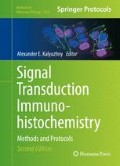Abstract
Multiplex staining of cell and tissue sections with antibodies raised in the same host species is a serious challenge because of unwanted but inevitable cross-reactivity of secondary antibodies with irrelevant primary antibodies. Several techniques can be used to overcome this obstacle including direct labeling of primary antibodies with fluorescent tags and using tyramide signal amplification. Unfortunately these techniques either lack sensitivity, or require a long multistep protocol which can cause physical damage of specimens. As an alternative, we have developed a protocol based on conjugation of primary antibodies to small-size hapten molecules which can be detected with hapten-specific fluorescent secondary antibodies. This technique has been used for two-color labeling of Y845 phosphorylated Epidermal Growth Factor Receptor (EGFR) and S139 phosphorylated histone H2AX protein in A431 human epidermoid carcinoma cells. Our novel hapten–anti-hapten detection chemistry allows for generating a stronger fluorescent signal and completely avoid cross-interactions of secondary antibodies with irrelevant primary antibodies.
Access this chapter
Tax calculation will be finalised at checkout
Purchases are for personal use only
References
Jia LT, Zhang R, Shen L et al (2015) Regulators of carcinogenesis: emerging roles beyond their primary functions. Cancer Lett 357(1):75–82
González JE, Barquinero JF, Lee M et al (2012) Radiosensitization induced by the anti-epidermal growth factor receptor monoclonal antibodies cetuximab and nimotuzumab in A431 cells. Cancer Biol Ther 13(2):71–76
Siddiqui MS, François M, Fenech MF et al (2015) Persistent γH2AX: a promising molecular marker of DNA damage and aging. Mutat Res Rev Mutat Res 766:1–19
Ashan A, Hiniker SM, Davis MA et al (2009) Role of cell cycle in epidermal growth factor receptor inhibitor-mediated radiosensitization. Cancer Res 69(12):5108–5114
Das AK, Sato M, Story MD et al (2006) Non-small cell lung cancers with kinase domain mutations in the epidermal growth factor receptor are sensitive to ionizing radiation. Cancer Res 66(19):9601–9608
Bagnyukova TV, Restifo D, Beeharry N et al (2013) DUSP6 regulates drug sensitivity by modulating DNA damage response. Br J Cancer 109(4):1063–1071
Kim K, Wu HG, Jeon SR (2015) Epidermal growth factor-induced cell death and radiosensitization in epidermal growth factor-overexpressing cancer cell lines. Anticancer Res 35:245–253
Würden S, Homberg U (1993) A simple method for immunofluorescent double staining with primary antisera from the same species. J Histochem Cytochem 41(4):627–630
Frisch J, Houchins JP, Grahek M et al (2011) Novel multicolor immunofluorescence technique using primary antibodies raised in the same host species. Methods Mol Biol 717:233–244
Owen GR, Häkkinen L, Wu C et al (2010) A reproducible technique for specific labeling of antigens using preformed fluorescent molecular IgG-F(ab’)2 complexes from primary antibodies of the same species. Microsc Res Tech 73(6):623–630
Author information
Authors and Affiliations
Corresponding author
Editor information
Editors and Affiliations
Rights and permissions
Copyright information
© 2017 Springer Science+Business Media LLC
About this protocol
Cite this protocol
Hagen, J., Schwartz, D., Kalyuzhny, A.E. (2017). Hapten–Anti-Hapten Technique for Two-Color IHC Detection of Phosphorylated EGFR and H2AX Using Primary Antibodies Raised in the Same Host Species. In: Kalyuzhny, A. (eds) Signal Transduction Immunohistochemistry. Methods in Molecular Biology, vol 1554. Humana Press, New York, NY. https://doi.org/10.1007/978-1-4939-6759-9_8
Download citation
DOI: https://doi.org/10.1007/978-1-4939-6759-9_8
Published:
Publisher Name: Humana Press, New York, NY
Print ISBN: 978-1-4939-6757-5
Online ISBN: 978-1-4939-6759-9
eBook Packages: Springer Protocols

